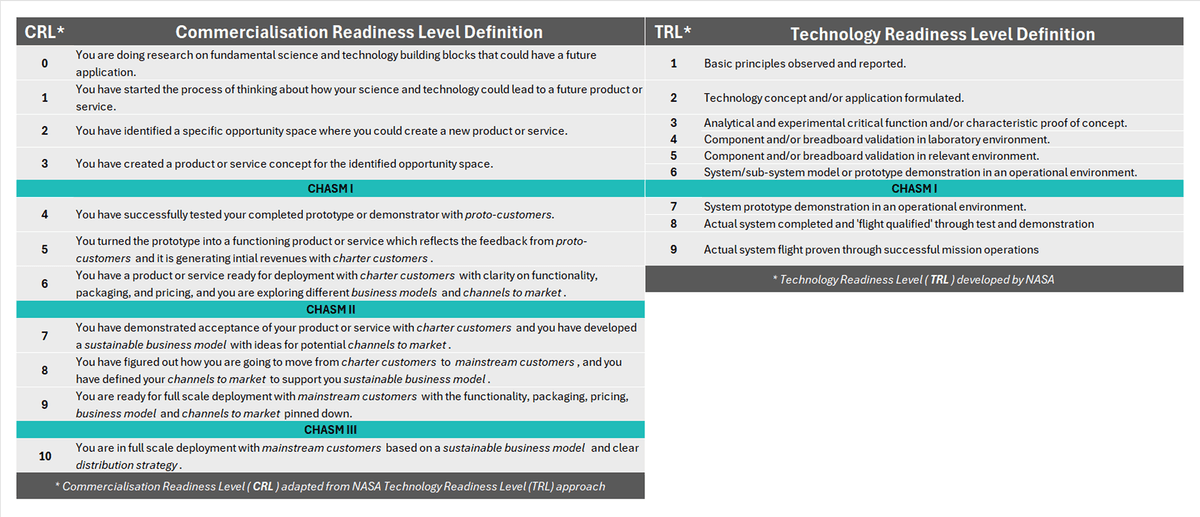The key challenge facing policymakers today is how we create growth. Whilst much has been written about industrial strategy and the critical role of innovation in generating growth, there is still a serious gap in understanding how innovation translates into growth: we need a better understanding of the commercialisation process, and the metrics associated with this growth trajectory.
The Triple Chasm Model, as we have discussed previously, is based on an AI-driven analysis of the empirical data associated with growth provides a rigorous basis for looking at this challenge. Fundamentally, this analysis confirms that this growth trajectory can be modelled using the simple diffusion equation, but with the three discontinuities in this journey, where growth stalls and the parameters in the diffusion equation change: hence the 3 Chasms behind the Triple Chasm Model which correspond to the development of prototypes, commercial acceptance of the product and the point at which serious scaling can begin.

The Three Chasms
While these 3 Chasms provide powerful calibration of the commercialisation journey, we need a finer scale to understand the maturity of any innovation more precisely: the Commercialisation Readiness Level, or CRL, provides this maturity metric which covers all aspects of the commercialisation trajectory from idea to full deployment and impact.
In contrast, most innovation agencies currently use Technology Readiness Level, or TRL as their growth metric, which suffers from two key problems:
- It only measures the readiness of the technology, not how it is deployed
- This metric runs out of steam soon after Chasm I is crossed
This problem has been recognised by many players, which is why there have been attempts to introduce other metrics, for example product readiness level, market readiness level, and business model readiness level, but these serve to complicate the picture because all these factors are inter-related and there is no integrated view of the maturity of an innovation: what is clearly required is an integrated metric which looks at the overall maturity of an innovation, which in turn can be affected by the 12 growth drivers (meso-economic vectors) defined by the Triple Chasm Model.
Use of CRL tackles these challenges head-on and provides a robust, repeatable way to measure the maturity of any innovation. Clearly there is a simple relationship between CRL and TRL as illustrated below.
CRL - TRL Comparison

CRL 0 - Research on fundamental science and technology building blocks that could have a future application.
CRL 1 - Started process of thinking about how your science and technology could lead to a future product or service.
CRL 2 - Identified a specific opportunity space where you could create a new product or service.
CRL 3 - Created a product or service concept for the identified opportunity space.
CRL 4 - Successfully tested your completed protoype or demonstrator with proto-customers.
CRL 5 - Turned the prototype into a functioning product or service which reflects the feedback from proto-customers and is generating intial revenues with charter customers.
CRL 6 - Have a product or service ready for deployment with charter customers with clarity on functionality, packaging, and pricing, and you are exploring different business models and channels to market.
CRL 7 - Demonstrated acceptance of your product or service with charter customers and you have developed a sustainable business model with ideas for potential channels to market.
CRL 8 - Figured out how you are going to move from charter customers to mainstream customers, and you have defined your channels to market to support you sustainable business model.
CRL 9 - Ready for full scale deployment with mainstream customers with the functionality, packaging, pricing, business model and channels to market pinned down.
CRL 10 - In full scale deployment with mainstream customers based on a sustainable business model and clear distribution strategy.
The message to policy makers is clear: design and measure the impact of your interventions based on CRL not TRL.
